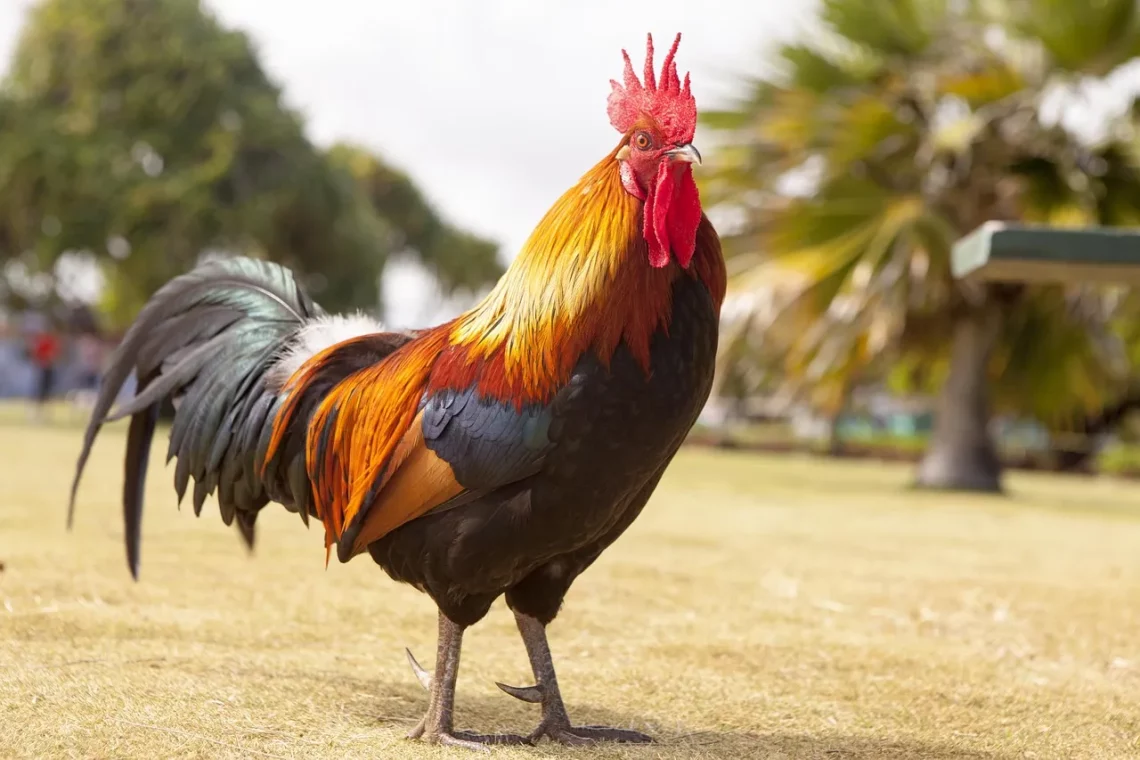
Stunning Images of Majestic Big White Roosters in Nature
The majestic big white rooster stands as a symbol of beauty, strength, and vitality in the natural world. Known for their striking appearance, these birds capture the imagination of many with their pristine plumage and commanding presence. Roosters, in general, have long been associated with various cultural significances, from heralding the dawn to representing fertility and prosperity. The big white rooster, in particular, has garnered attention for its stunning aesthetics and impressive characteristics.
In nature, these birds exhibit remarkable behaviors, often showcasing their dominance within flocks while also engaging in intricate social interactions. Their vibrant personalities and lively antics make them a joy to observe, whether in a farmyard setting or their natural habitat. The contrast of their dazzling white feathers against lush green fields or golden sunsets provides a feast for the eyes, offering countless opportunities for photography and artistic expression.
Beyond their visual appeal, big white roosters play important roles within their ecosystems, contributing to pest control and overall biodiversity. Their foraging habits help maintain the balance in various environments, ensuring that the natural order is preserved. This unique interplay between beauty and utility is what makes these birds so captivating. As we delve deeper into the world of the majestic big white roosters, we will explore their characteristics, behaviors, and the environments they thrive in.
Characteristics of Big White Roosters
Big white roosters are easily identifiable by their striking white feathers and robust stature. Often regarded as one of the most visually appealing breeds, these birds boast a blend of elegance and strength. Their plumage shines in the sunlight, creating a brilliant white backdrop that enhances their regal demeanor. The color of their feathers is not merely for show; it also plays a role in attracting mates and establishing dominance within flocks.
The size of these roosters is also a notable feature. They tend to be larger than many other breeds, with a well-defined muscular build. This physicality not only aids in their ability to defend their territory but also contributes to their presence as a dominant figure in their environment. Alongside their size, big white roosters possess a distinctive comb and wattle, which can vary in shape and size depending on the specific breed. These features are not just ornamental; they help regulate body temperature and play a role in the mating process.
In terms of temperament, big white roosters are known for their assertive nature. They usually display a confident demeanor and are often the first to sound the alarm in the presence of potential threats. This vigilance is crucial for the safety of the entire flock. Their crowing, a loud and distinctive call, serves multiple purposes: it marks their territory, communicates with other chickens, and even attracts hens.
Moreover, big white roosters exhibit a variety of behaviors that are fascinating to observe. From their courtship displays to their interactions with hens and other roosters, these birds have a complex social structure. They engage in rituals that reinforce their status within the flock, often through displays of strength or through elaborate mating dances.
Natural Habitats and Environments
Big white roosters can thrive in a variety of environments, although they are most commonly associated with rural and agricultural settings. Their adaptability is one of the key factors contributing to their widespread popularity. Whether in a backyard coop or a sprawling farm, these birds can find a way to flourish.
In their natural habitats, big white roosters often roam freely, foraging for food and exploring their surroundings. They have a diverse diet that includes grains, seeds, insects, and even small plants. This foraging behavior not only supports their health but also plays a significant role in maintaining the ecosystem. By eating pests, they help control insect populations, thus benefiting the overall agricultural environment.
Moreover, their ability to acclimate to different climates is noteworthy. While they prefer moderate temperatures, big white roosters can handle varying weather conditions as long as they have proper shelter and access to food and water. In colder climates, they may develop thicker feathers, providing insulation against the chill. Conversely, in warmer climates, they adapt by seeking shade and water to keep cool.
The presence of big white roosters in natural settings also contributes to the biodiversity of the area. They can coexist harmoniously with other wildlife, and their activities support the health of the ecosystem. For example, their scratching and pecking help aerate the soil, promoting plant growth and enhancing the habitat for other creatures.
Furthermore, the picturesque landscapes in which these birds are often found add to their allure. Imagine a serene farm at dawn, with big white roosters crowing against a backdrop of rolling hills and golden fields. This idyllic scene not only captivates the eye but also highlights the essential role that these birds play in the agricultural landscape.
Behavioral Patterns and Social Structure
The behavioral patterns of big white roosters are as fascinating as their physical characteristics. These birds exhibit a range of social behaviors that reflect their status within the flock and their interactions with their environment. Understanding their social structure can provide insight into the dynamics of their groups and the roles that different individuals play.
Big white roosters are typically dominant figures in their flocks. They establish a pecking order, where each bird knows its place in relation to others. This hierarchy is essential for maintaining order and reducing conflicts. The dominant rooster often takes the lead in foraging and alerting the group to potential dangers. His assertiveness ensures that the flock remains cohesive and protected.
Courtship behaviors among big white roosters are particularly interesting. During mating season, a rooster will often display elaborate rituals to attract hens. This may include puffing up his feathers, performing a dance, and producing specific calls. These displays serve to showcase his health and vitality, signaling to the hens that he is a worthy mate.
In addition to courtship, roosters engage in various forms of communication with their flock. They use vocalizations, body language, and even physical interactions to convey messages. For instance, a sudden loud crow can indicate a threat, while softer clucks may signal contentment or the availability of food. Observing these interactions can provide a deeper understanding of their social dynamics.
Moreover, big white roosters are known for their protective instincts. They will often take on aggressive behaviors to defend their territory from intruders, whether these are other birds or predators. This protective nature is vital for the survival of the flock, ensuring that hens and chicks are safe from harm.
Overall, the behavioral patterns of big white roosters reflect a complex social structure that is both fascinating and essential for their survival. Their interactions with each other and their environment highlight the intricate balance of nature and the roles that different species play within it.
The Cultural Significance of Roosters
Roosters, including the majestic big white variety, hold a significant place in various cultures around the world. Their prominence in folklore, art, and symbolism speaks volumes about their impact on human societies throughout history. From ancient civilizations to modern times, roosters have been revered for their qualities and have inspired a wealth of cultural narratives.
In many cultures, roosters symbolize dawn and new beginnings. Their crowing at the break of day has made them a natural herald of morning, representing hope and the promise of a fresh start. This connection to dawn is particularly evident in various mythologies, where roosters are often linked to sun deities or considered protectors against darkness.
Additionally, roosters are frequently seen as symbols of courage and vigilance. Their assertive behavior and protective instincts make them emblematic of bravery in the face of adversity. This symbolism is often reflected in art, literature, and even astrology, where certain zodiac signs are associated with the qualities of the rooster.
In culinary traditions, the rooster has also earned its place. Many cultures feature rooster meat in their cuisine, and dishes that highlight this bird are often considered delicacies. The culinary significance of roosters further underscores their importance in agricultural practices and food culture.
Furthermore, the rooster’s vibrant and striking appearance has inspired countless artists and photographers. The big white rooster, with its stunning plumage, serves as a muse for creative expression, capturing the beauty of nature in various art forms. Photographers seek out these birds to showcase their elegance and charm, often leading to stunning imagery that celebrates their majesty.
In summary, the cultural significance of roosters, particularly big white ones, extends far beyond their physical characteristics. Their roles as symbols of new beginnings, courage, and creativity highlight the profound impact they have had on human societies and continue to inspire generations.
In conclusion, the majestic big white rooster is truly a remarkable creature, embodying beauty, strength, and cultural significance. Their presence in nature not only enhances our environment but also enriches our lives through their captivating behaviors and vibrant personalities. As we continue to appreciate these incredible birds, let us also recognize their essential roles in our ecosystems and cultures.




